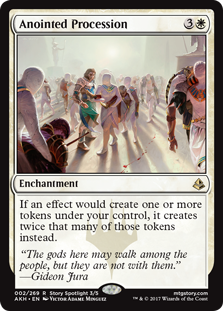
Conventionally in Magic a "do nothing" refers to an expensive spell that has no effect on the board. Anointed Procession is a good example of such a card. On its own it literally does nothing, you need other stuff going on to benefit from playing it. The card doesn't have to be bad to be a do nothing, it just means you will likely have a deck heavily built around it. It is however usually a derogatory term for arguing why a card might be weak. "Fact or Fiction is a bit of a do nothing" is something I am sure I have said in the past despite it not strictly being true, just in the sense that you spend a lot of mana for no immediate impact on the board. In cube, do nothings in either sense are pretty uncommon. You cannot go spending a chunk of mana to have no immediate effect. Powerful cards like Anointed Procession are too narrow to bother building around and powerful cards like Fact or Fiction are simply too much of a tempo concession these days.
In cube a whole different kind of "do nothing" card have become increasingly popular. Rather than cards that do nothing due to being expensive and then requiring further conditions to be met to enact their effect thus ultimately doing nothing, the cube do nothings are low resource cost cards that have incredibly minor, often negligible effects. Essentially the cube do nothing cards are all just low cost cantrips.
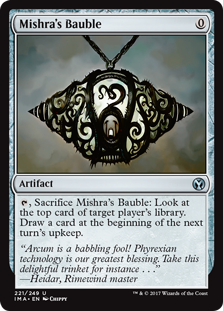
By low resource cost I mean both cards and mana. Every card on this list replaces itself ensuring no card cost. Most cost one mana with a few less and a few at a mighty two mana. All these cards are incredibly cheap all round but none of these cards however do anything of anything that directly progresses a game. None provide any tempo and none affect the board in a meaningful way by themselves. There isn't really any card advantage or quality on offer within this list either. You could call cards like Serum Visions a do nothing but we all know the power of card quality and filtering. I wanted to bring attention to the potency of cards we don't really consider card quality and as such don't get quite as much prestige. These cards are effectively the other kinds of Serum Visions, they provide quality of other things, often mana or information. Perhaps they offer an option on doing something situational but at such a low cost that even if you only use it for that 1 in 20 games it is still worth it.
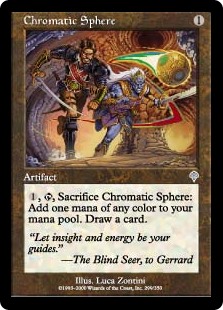
A lot of these cards don't immediately seem worth playing on their own and that is often the case. You are frequently playing cards such as these not just for their minor effects but to empower other elements of your deck. Things like prowess, delve, delirium, metalcraft, affinity, revolt, and many many more key words can be boosted. When you take a card with zero cost that does nothing that sounds fair. When you scale that card with anything that makes it do something you have suddenly gained a massive amount of value on that card. Often a mere shuffle for free can be well worth that deck slot. Even more often it is those deck slots you are trying to reduce. If you have a near full deck which is great but no remaining good options for that deck you ideally want to fill it up with cheap cycling cards, most of which are do nothings! The more you can pad out a good list with cheap cantrip support cards rather than mediocre conventional cards the better off you will be. This is especially the case in high synergy or themed decks. Just reducing variance is a big win in singleton and these kinds of cards help a lot with that. It is worth noting that it is curve unsuitability rather than card power level in cube that leads to something being replaced with a do nothing. You usually wind up a bit top heavy in most pools. Your five drops might all be decent but running a couple too many is going to be detrimental to your chances and this is where a lot of these cards are getting their action from.
So, to do nothing and qualify for this list you have to have no tempo effect on the board. No ability to remove permanents or make creatures. No ability to apply any pressure on winning the game. No card advantage. No disruptive capabilities. No card filtering is allowed on this list either (scry, loot etc) although technically it should be, it is just well covered in other writings and well known for it's power. Most of the things we will look at here see a lot of play in my cube and they really don't get the credit they deserve. There are a number of exceptions to my criteria but only very mildly. It is a pretty hard one to define. I shall draw attention to why cards break the rules and why I think they still qualify as a cheap do nothing. Hopefully by the end of the list the value of these things will be better understood and why I have put them all together in this group will make good sense.
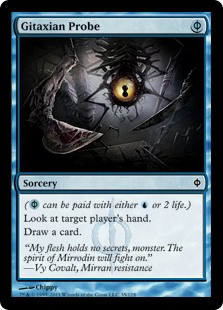
There are several smaller groups of cards I want to lump together and discuss before going onto the list. There are also a couple of different groups that overlap in different ways. I find it most useful to look at effect for grouping but if we wanted to group by mana cost we would be better positions to know which are the most played. So, this first group, the 0 mana cards, are easily the most played across all magic formats. Scaling on a 0 mana effect is infinitely more impressive than that same scaling on a card with a greater cost. These cards all do fairly different things but they all share the main trait of being 0 mana net. They are abused in a wide variety of ways and are fairly well documented already. All are certainly playable in any cube and almost all of them can slot into any deck without issue. Often improving that deck, sometimes abusively.
Mishra's Buable
Urza's Bauble
Street Wraith
Manamorphose
Gitaxian Probe
Land Grant
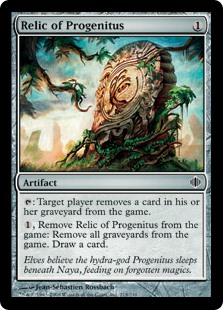
After this group I am just going to do cards based on effect. The free cards will therefore crop up again in their appropriate category. I have included a few two mana cards, most of which you can split the cost over turns. These are rather less played and less relevant and so have no need of a special group to identify them. Typically these two mana "do nothings" have a more significant effect on the game. Typically these are the more situational things that are pretty useful in some matchups and have no relevance in others. The best examples of this includes the cards which exile cards from graveyards. Here we have
Cremate
Nihil Spellbomb
Phyrexian Furnace
Scrabbling Claws
Relic of Progenitus
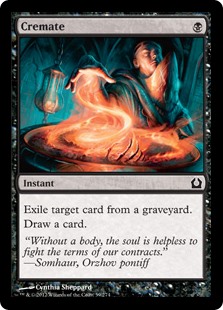
Cremate comes close to not counting as it needs a target making it situational. While this will often not be the case you frequently want to cycle it early and early is the most likely time it will be dead. There are other cards like these graveyard haters and often they are better at the disruptive side but they either cost more to return value or don't cantrip and as such cannot be included at minimal cost to a build.
The other group of cards that can help hedge in specific matchups, and hence having a few more two mana options, are the cards that gain life. These typically see fairly little play as when you want life it implies you are under tempo pressure and when you are under tempo pressure you don't want to be spending your mana in a way that doesn't change the board. You are far better off with cards that gain life in a very mana efficient way or as part of doing something else useful. See Kor Firewalker, Baneslayer Angel, Sphinx's Revalation etc. None the less, in this group we have;
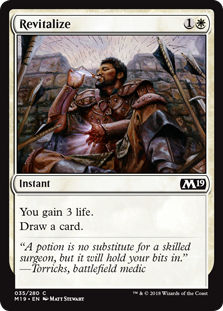
Implement of Improvement
Bandage
Heal
Prophecy
Fountain of Renewal
Revitalize
Renewed Faith
Scroll of Avacyn
While I ruled out cards like Silent Gravestone from the yard hating cards for costing too much total I am happier including Fountain of Renewal in this list as you want to keep it in play when under pressure and want to cash it in when you are running out of gas. It just slots in with the flow of the game better. It is noteworthy that you cannot really consider Fountain as thinning of a deck when looking at land ratios which is a shame. That is a big part of what most of the cards in this article are used for. I wanted to include Fountain because it is really the only pure life card that gets played now. Renewed Faith gets some attention in cycling decks and Zuran Orb for certain combos but neither just because you want more life.

Next up we have one of the bigger groups which is the fixing. Fixing is so good that these cards will see a lot of play simply for the primary effect of fixing mana. Any deck with a dodgy mana base will happily pad out a list with some of these cards. There are pros and cons to most of them. Some you want the card upfront so that you can have a thing in play. Some you want just to sacrifice so 1are happy with getting the card back on EtB or going to the bin just so long as it is not tied up with using the card for the effect. Some you want with a built in ability to sacrifice so you can get them into the bin without any help. Some are one off fixing, others ongoing. The latter is obviously better for actual fixing but as such usually costs a little more. These are some of the most commonly used support cards not just for their potential to help fix but also because of their effectiveness at assisting with card type matters effects. Metalcraft, delirium and that sort of thing. Certainly for cube play these are among the best do nothing cards.
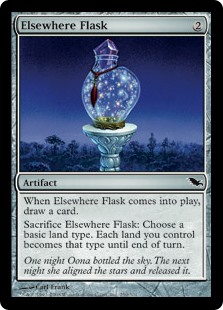
Abundant Growth
Unbridled Growth
The Egg Cycle
Terrarion
Chromatic Sphere
Barbed Sextant
Chromatic Star
Manamorphose
Arcum's Astrolabe
Prophetic Prism
Guild Globe
Elsewhere Flask
Golden Egg
In a similar sort of vein to these mana fixing cards we have the Lay of the Land cards. Mostly these are green but there are a couple outside the colour. They are slightly different to a cantrip in that they always find a land. As such you play these for more specific reasons and they count more heavily towards your effective land count. Sometimes it is fixing, sometimes it is deck thinning, shuffles, filling up the bin etc. Often I find playing these so that I can fine tune a mana base so that I have the best spread of lands over the course of a game. Not too few early, not too many late! The many iterations of cycling land are basically just the reverse of these cards in that they are land into card rather than card into land. These cards let you play on the lighter side with lands while cycling lands let you go heavier. They are both great in that they blur the line between spells and land and let you have some buffer in your build ratios and draws. These spells are the least do nothing on the list due to having a couple of specific roles that most builds can get behind. You don't tend to play these as pure filler, it is more like half a land slot and half a filler slot. Lands are the opposite of a do nothing (except in late game floods which these cards help prevent) in that lands are the things that enable almost all of the doing! This group does tend to have some of the biggest potential conditional upsides ranging from ramp to card advantage to tutoring to bonus free energy.
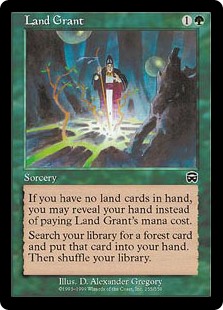
Land Grant
Renegade Map
Tithe
Traverse the Ulvenwald
Attune with the Aether
Open the Gates
Caravan Vigil
Wanderer's Twig
Traveler's Amulet
Cycling Lands of which there are at least 4 cycles
Next in line we have a group of cards that alter something else a little. These fall into two distinct groups, of which only really one qualifies for this article. The first group requires specific targets, usually creatures. This makes them occasionally dead cards like Cremate and as such really poor support, filler or cantrips! I only ever play this targetting group when I specifically want the effect they provide and expect to be able to use it most of the time. This first group is easily the biggest group and I have not bothered to provide an exhaustive list, just some examples from it. The second part of this group is rather smaller but the cards are a whole lot more playable due to not needing a target. They typically affect a subsequent spell rather than a creature as the first group does.

Implement of Ferocity
Expedite
Defiant Strike
Fleeting Distraction
Frog Tongue
Panic Spellbomb
Leap
Slip Through Space
Shadow Rift
Wisp Cycle
Twisted Image
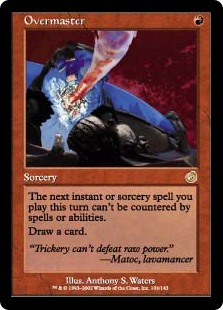
The modifiers without target restriction;
Crash Through
Warlord's Fury
Scout's Warning
Quicken
Insist
Overmaster
Next up is the smallest group but a highly payed group none the less. These are the mill cards and they are great for a load of reasons. Some can be disruptive against people using top of library tutors or any other top of library placement effect. Sometimes they will just kill people in the longer games! Mostly they are used to empower all sorts of things ranging from delve to delirium. They provide value with self recursive and flashback cards. They provide psuedo card quality when you have other forms of recursion. They provide effective mana boosts in combination with the right cards. They can even be direct card quality when used to mill away known unwanted cards. Calling the mill cards do nothings is a bit of a stretch given quite how much they do actually do. They are some of the most powerful and diverse support cards in cube. At least as per my definition at the start they qualify as a do nothing!
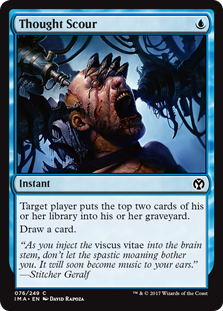
Ray of Erasure
Mental Note
Thought Scour
Nearly at the end of this we have the lookers. These are the cards that provide information. You get to look at cards in hands or libraries. This group includes some of the most undercost cards in the game. Information can be worth vast amounts. It can also be counterproductive if you use it poorly. It is a very difficult resource to quantify. It scales with skill and options almost exclusively and with a vast range. I have included a couple of cards that not only look at your library but let you rearrange a bit of it too. This is the grey area between card quality and information. You are really only getting selection out of these cards in a short term basis unless you pair them with other shuffle and library manipulation effects. Brainstorm starts to look like it fits on this section if we include these card quality loan style effects and assume no synergies. Think of the cards how you will, they were mostly included to illustrate the point that things are rarely cut and dry one thing or another and that most things in magic exist on a scale.
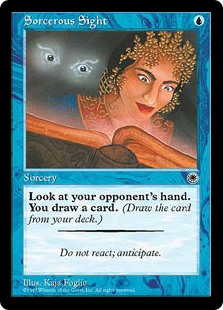
Sensei's Diving Top
Mirri's Guile
Peek
Sorcerous Sight
Clairevoyance
Mishra's Bauble
Urza's Bauble
Gitaxian Probe
We have a group of cards next that are all just cyclers with some potential upside in rare situations. Some provide potential extra value in cards and some provide an option on alternative uses. Basically any card with cycling for no more than one mana falls into this latter camp. This is only really the case however when you expect to cycle the card far more often than playing it. In the case of some of the better cycling cards you do actively want the effect most of the time and that is why you play it. As such Cast Out probably has no place on this list of do nothings. Also, cycling is not triggering a lot of things like prowess and so might well not be ticking synergy boxes. Yet more blurred lines in these cantrip and do nothing definitions.
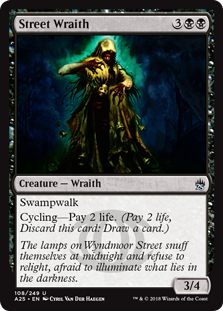
Visions of Beyond
Obsessive Search
Reach Through Mists
Whisper's of the Muse
Sapphire Charm
Censor
Curator of Mysteries
Heiroglyphic Illumination
Cast Out
Dissenter's Deliverance
Spark Spray
Street Wraith
Actually last we have a small group of oddities that fail to fit into any other group neatly. Mostly this is just due to lack of redundancy meaning there is no larger group to put them in. A pinger and a single target super long term recursion effect. The former is so mana inefficient and low relevance that even though it does technically progress the game it effectively doesn't. Mostly it is only played in red decks with a need of bolstering artifact support. The latter is used a lot in singleton combo decks where having key parts dealt with is an issue but finding stuff you need on the bottom of your library is not.
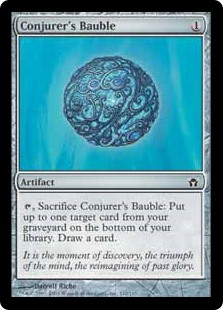
Implement of Combustion
Conjourer's Bauble
Top 10 for the do nothings as far as a drafting cube goes. Peek would be on this list if everyone is a high standard of play. Due to do nothings being things you most often play to enhance other deck synergies the top X list is a little pointless as you are always playing the one most appropriate to your synergies or needs. This list is based as much on % play as possible.

10. Renegade Map
9. Abundant / Unbridled Growth
8. Chromatic Sphere
7. Traverse the Ulvenwald
6. Mishra's and Urza's Bauble
5. Mental Note / Thoughtscour
4. Tithe
3. Terrarion / Chromatic Star
2. Arcum's Astrolabe
1. Gitaxian Probe